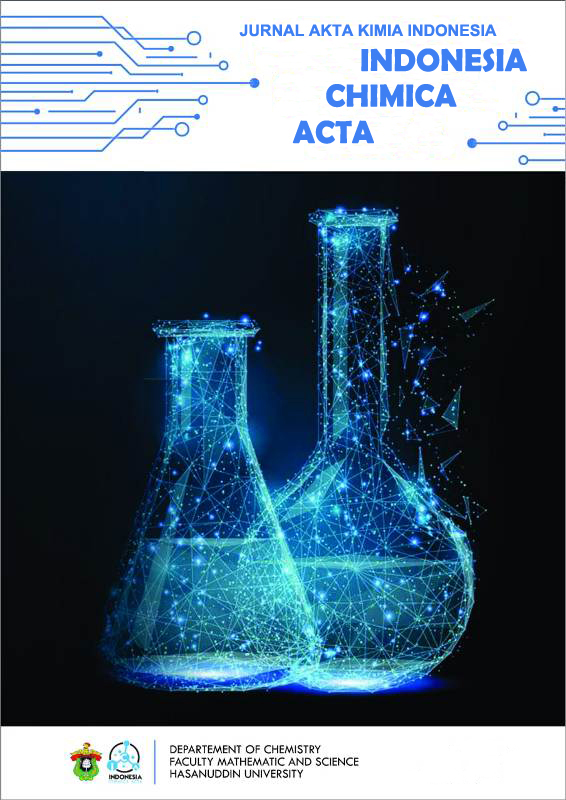Collagen Extraction from Bone of Lutjanus sp. and Toxicity Assay
Abstract
Indonesia is a maritime country with the potential fisheries resources. However, utilization only revolves around the meat, while other parts have not been used optimally, especially fish bones which have the potential to produce collagen, so it needs to be developed. The aims of this study ware extracted collagen from bone of Lutjanus sp. and determine its the Anticancer activity. The collagen was extracted by using hydroextraction method and identification by FTIR. The initial screening anticancer activity was done by using Brine Shrimp Lethality Test (BSLT) method for toxicity assay. The results showed that the yield of collagen was 4.535% with protein concentration was 8,815 mg/mL. Identified collagen from spectrum of amide A, B, I, II, and III at 3421.72; 2926.01; 1651.07; 1541.12; 1240.23 cm-1. The toxicity test was shown in LC50 values of 8,760 μg/mL. The collagen from Lutjanus sp. bone can be used as natural anticancer agent.
Full text article
References
Gelse KP, Aigner T. Collagens—Structure, Function, and Biosynthesis. Adv Drug Deliv Rev 2003; 55: 1531–1546.
Duarte AS, Correia A, Esteves AC. Bacterial collagenases – A review. Crit Rev Microbiol 2016; 42(1): 106-126.
Shoulders MD, Raines RT. Collagen Structure and Stability. Annu Rev Biochem 2009; 78: 929-958.
Silva TF, Penna ALB, Colágeno: Características Químicas E Propriedades Funcionais. Rev Inst Adolfo Lutz 2012; 71(3): 530-539.
Silvipriya KS, Kumar KK, Bhat AR, Kumar D, John A, Lakshmanan P. Collagen: Animal Sources and Biomedical Application. J Appl Pharm Sci 2015; 5(03): 123-127.
Lee CH, Singla A, Lee Y. Review Biomedical Applications of Collagen. Int J Pharm 2001; 221: 1-22.
Muthukumar T, Sreekumar G, Sastry TP, Chamundeeswari M. Collagen as A Potential Biomaterial in Biomedical Applications. Rev Adv Mater Sci 2018; 53: 29-39.
Han SH, Uzawa Y, Moriyama T, Kawamura Y. Effect of Collagen and Collagen Peptides from Bluefin Tuna Abdominal Skin on Cancer Cells. Health 2011; 3(3): 129-134.
Baehaki A, Nopianti R, Anggraeni S. Antioxidant Activity of Skin and Bone Collagen Hydrolyzed from Striped Catfish (Pangasius pangasius) with papain enzyme. J Chem Pharm Res 2015; 7(11): 131-135.
Silva MH, Silva JM, Marques ALP, Domingues A, Bayon Y, Reis RL. (Review) Marine Origin Collagens and Its Potential Applications. Mar Drugs 2014; 12: 5881-5901
Schmidt MM, Dornelles RCP, Mello RO, et al, Collagen Extraction Process. IFRJ 2016; 23(3): 913-922.
Liu H, Huang K. Structural Characteristics of Extracted Collagen from Tilapia (Oreochromis mossambicus) Bone: Effects of Ethylenediaminetetraacetic Acid Solution and Hydrochloric Acid Treatment. Int J F Prop 2016; 19(1): 63-75.
Kittiphattanabawon P, Benjakul B, Visessanguan W, Nagai T, Tanaka M. Characterisation of acid-soluble collagen from skin and bone of bigeye snapper (Priacanthus tayenus). Food Chem 2005; 89: 363–372.
Nagai T, Suzuki N. Isolation of Collagen from Fish Waste Material -Skin, Bone and Fins. Food Chem 2000; 68: 277-281.
Baehaki A, Lestari SD, Desliani I. Collagen Hydrolysis from Skin and Bone of Pangasius Catfish Prepared by Bromelain Enzyme and Antioxidant Activity of Hydrolysate. Der Pharma Chemica 2016; 8(4): 155-158.
Veeruraj A, Arumugam M, Balasubramanian T. Isolation and Characterization of Thermostable Collagen from The Marine Eel-Fish (Evenchelys macrura). Process Biochem 2013; 48: 1592–1602.
Tziveleka LA, Ioannou E, Tsiourvas D, Berillis P, Foufa E, Roussis V. Collagen from The Marine Sponges Axinella cannabina and Suberites carnosus: Isolation and Morphological, Biochemical, and Biophysical Characterization. Mar Drugs 2017; 15(152): 1-17.
Hamidi MR, Jovanova B, Panovska TK. Toxicоlogical Evaluation of The Plant Products Using Brine Shrimp (Artemia salina L.) Model. Maced pharm bull 2014; 60 (1): 9-18.
Authors
This is an open access journal which means that all contents is freely available without charge to the user or his/her institution. Users are allowed to read, download, copy, distribute, print, search, or link to the full texts of the articles in this journal without asking prior permission from the publisher or the author.
Jurnal Akta Kimia Indonesia (Indonesia Chimica Acta) operates a CC BY-SA 4.0 © license for journal papers. Copyright remains with the author, but Jurnal Akta Kimia Indonesia (Indonesia Chimica Acta) is licensed to publish the paper, and the author agrees to make the article available with the CC BY-SA 4.0 license. Reproduction as another journal article in whole or in part would be plagiarism. Jurnal Akta Kimia Indonesia (Indonesia Chimica Acta) reserves all rights except those granted in this copyright notice.

